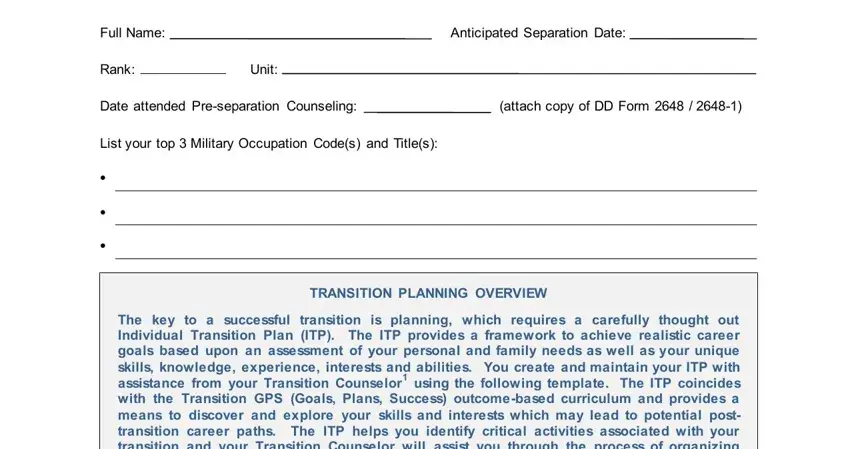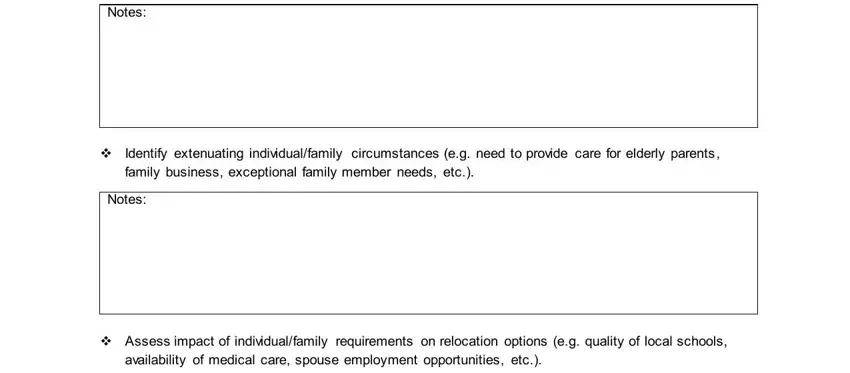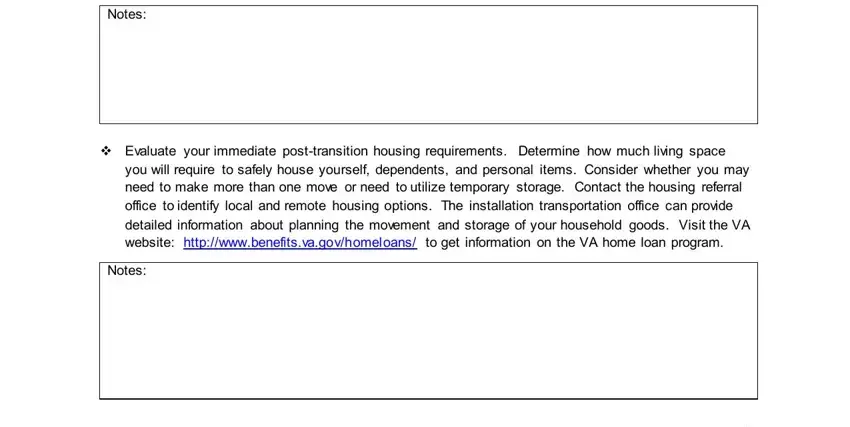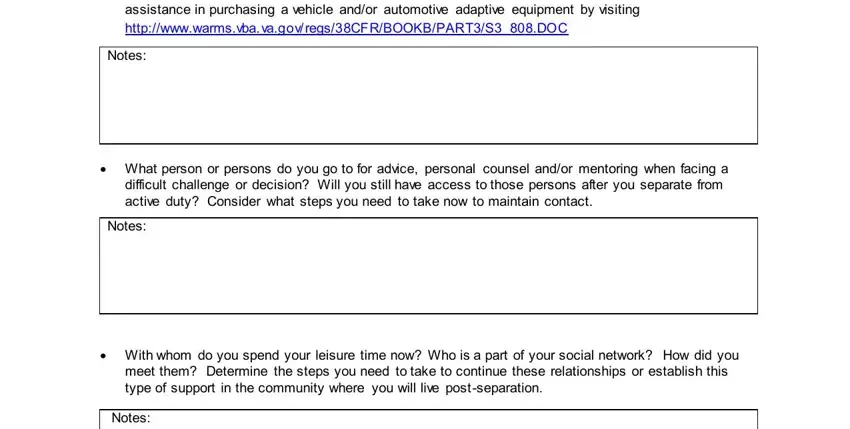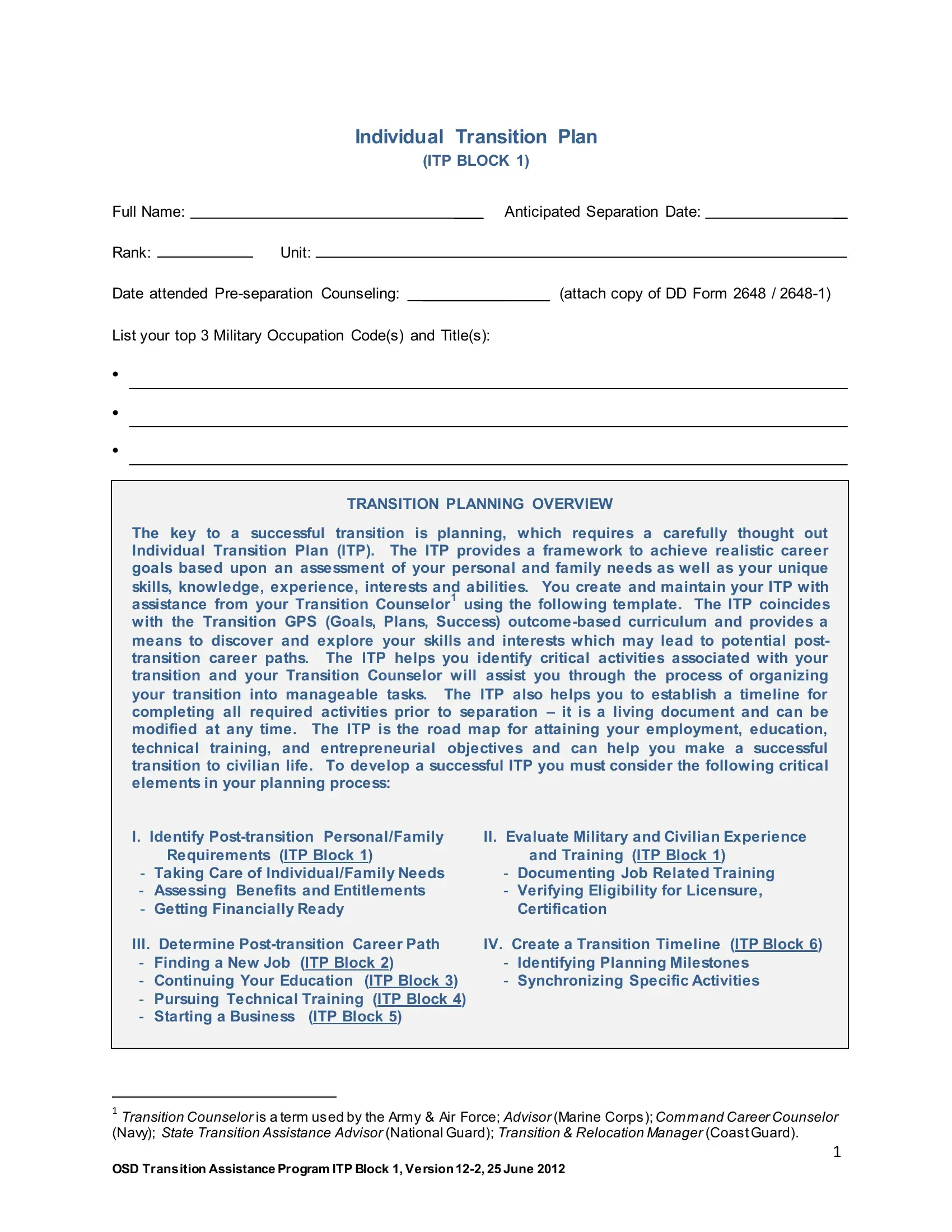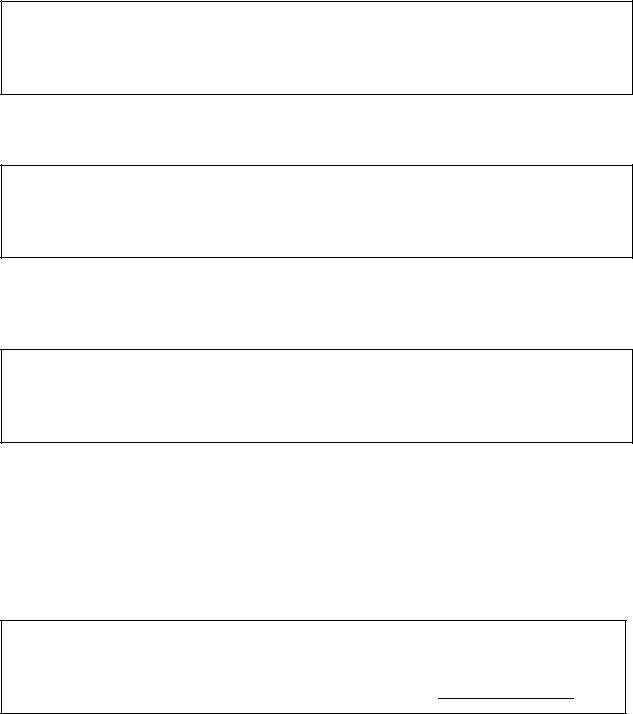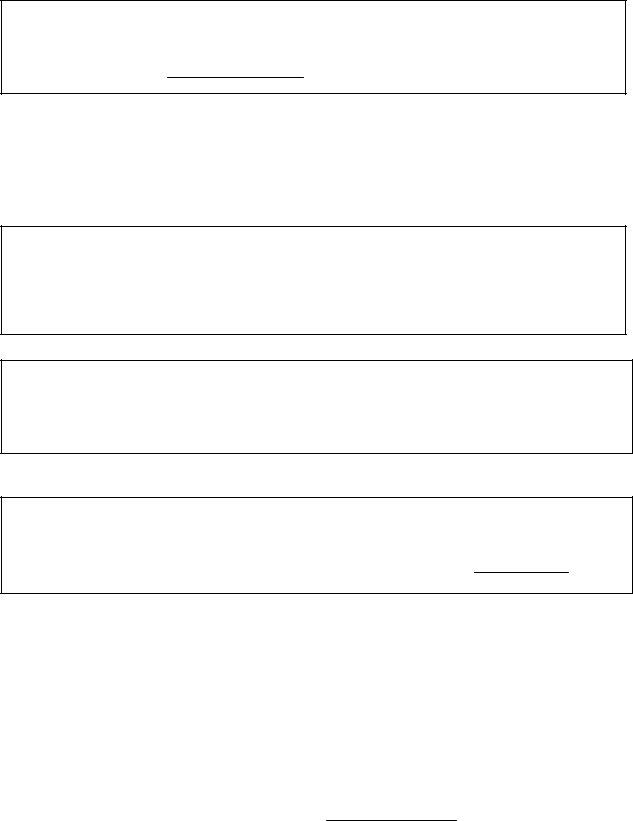|
|
Individual |
Transition Plan |
|
|
(ITP BLOCK 1) |
Full Name: |
|
Anticipated Separation Date: |
Rank: |
|
Unit: |
|
|
|
Date attended Pre-separation Counseling: |
(attach copy of DD Form 2648 / 2648-1) |
List your top 3 Military Occupation Code(s) and Title(s):
∙
∙
∙
TRANSITION PLANNING OVERVIEW
The key to a successful transition is planning, which requires a carefully thought out Individual Transition Plan (ITP). The ITP provides a framework to achieve realistic career goals based upon an assessment of your personal and family needs as well as your unique skills, knowledge, experience, interests and abilities. You create and maintain your ITP with assistance from your Transition Counselor1 using the following template. The ITP coincides with the Transition GPS (Goals, Plans, Success) outcome-based curriculum and provides a means to discover and explore your skills and interests which may lead to potential post- transition career paths. The ITP helps you identify critical activities associated with your transition and your Transition Counselor will assist you through the process of organizing your transition into manageable tasks. The ITP also helps you to establish a timeline for completing all required activities prior to separation – it is a living document and can be modified at any time. The ITP is the road map for attaining your employment, education, technical training, and entrepreneurial objectives and can help you make a successful transition to civilian life. To develop a successful ITP you must consider the following critical elements in your planning process:
|
|
|
|
|
|
|
|
I. Identify Post-transition Personal/Family |
II. Evaluate Military and Civilian Experience |
|
|
|
|
|
|
|
|
|
|
Requirements (ITP Block 1) |
|
|
and Training (ITP Block 1) |
|
|
- |
Taking Care of Individual/Family Needs |
|
- |
Documenting Job Related Training |
|
|
- |
Assessing Benefits and Entitlements |
|
- |
Verifying Eligibility for Licensure, |
|
|
- |
Getting Financially Ready |
|
|
Certification |
|
|
|
|
|
|
|
|
|
|
|
|
|
|
|
III. |
Determine Post-transition Career Path |
IV. Create a Transition Timeline (ITP Block 6) |
|
|
|
|
|
|
|
|
|
- |
Finding a New Job (ITP Block 2) |
|
- |
Identifying Planning Milestones |
|
|
- |
Continuing Your Education (ITP Block 3) |
|
- |
Synchronizing Specific Activities |
|
-Pursuing Technical Training (ITP Block 4)
-Starting a Business (ITP Block 5)
1Transition Counselor is a term used by the Army & Air Force; Advisor (Marine Corps); Command Career Counselor (Navy); State Transition Assistance Advisor (National Guard); Transition & Relocation Manager (Coast Guard).
1
OSD Transition Assistance Program ITP Block 1, Version12-2, 25 June 2012
CAREER READINESS STANDARDS
Prior to completing your Individual Transition Plan (ITP), it is important to note that there are Career Readiness Standards you will be expected to meet. You will be required to provide documentation of meeting the following readiness standards to your Transition Counselor and Command representative prior to separation. These standards are designed to increase your ability to successfully overcome any challengesyou may face in pursuit of your chosen career path. Some Career Readiness Standards apply to all career paths (Employment, Education, Technical Training and Entrepreneurship) while others only apply to a specific career path.
Career Readiness Standards Applicable to all Career Paths ***
•Attend Pre-Separation Counseling
•Complete Pre-Separation Counseling Checklist DD Form 2648 / DD Form 2648-1
•Register for VA Benefits (eBenefits)
•Prepare a Post-Separation 12-month budget reflecting personal and familygoals and obligations
•Evaluate opportunties presented bycontinuing militaryservice in a Reserve Component
•Crosswalk militaryskill set to civilian skills (MOS crosswalk) to include an evaluation of the demand for those civilian skills within the potential relocation destinations
•Identify and document requirements and eligibilityfor licensure, certification and apprenticeships at the potential relocation destinations
•Complete the Individual Transition Plan and provide documentation of meeting the Career Readiness Standards for the chosen career path
Employment Career Readiness Standards***
•Complete the DANTES or other DoD-approved standardized career assessment tool selected by your militaryService
•Prepare and submitthe Job Application Package (e.g., create resume, identifyreferences,submitat least two employment applications, and/or provide a job acceptance letter)
•Obtain a “Gold Card” Certificate from the Department of Labor
Education Career Readiness Standards***
•Complete an education needs assessment
•Identify, compare, and selectacademic institutions based on specific selection criteria
•Prepare and submit an Education Application Package (e.g., submit application to academic institution and/or provide an acceptance letter)
•Schedule one-on-one counseling with the academic advisor from the institution you will attend
•Connect with the Student Veteran Organization at your chosen institution
Technical Training Career Readiness Standards***
•Complete an education needs assessment
•Identify, compare, and select technical training institutions based on specific selection criteria
•Prepare and submit a Technical Training Application Package (e.g., submit application to technical training institution and/or provide an acceptance letter)
•Schedule one-on-one counseling with the academic advisor from the institution you will attend
•Connectwith the Student Veteran Organization at your chosen institution
***Career Readiness Standards are noted by 3 asterisks throughout the Individual Transition Plan
2
OSD Transition Assistance Program ITP Block 1, Version12-2, 25 June 2012
PERSONAL ASSESSMENT
Section I. Identify Post-transition Personal/Family Requirements
A. Taking Care of Individual/Family Member Needs
Identify individual/family needs such as medical care, expenses, and location of potential providers. Notes:
Identify extenuating individual/family circumstances (e.g. need to provide care for elderly parents, family business, exceptional family member needs, etc.).
Notes:
Assess impact of individual/family requirements on relocation options (e.g. quality of local schools, availability of medical care, spouse employment opportunities, etc.).
Notes:
Evaluate your immediate post-transition housing requirements. Determine how much living space you will require to safely house yourself, dependents, and personal items. Consider whether you may need to make more than one move or need to utilize temporary storage. Contact the housing referral office to identify local and remote housing options. The installation transportation office can provide detailed information about planning the movement and storage of your household goods. Visit the VA website: http://www.benefits.va.gov/homeloans/ to get information on the VA home loan program.
Notes:
3
OSD Transition Assistance Program ITP Block 1, Version12-2, 25 June 2012
Consider your post-transition transportation requirements. Determine if you have adequate reliable personal transportation to take you to and from your place of employment or school. Evaluate your commuting options and whether you need to purchase another vehicle(s) for your spouse and/or dependents. Identify your post-transition transportation expenses to include: purchase costs, vehicle registration, insurance, maintenance, fuel, etc. If you are disabled, determine if you are eligible for assistance in purchasing a vehicle and/or automotive adaptive equipment by visiting http://www.warms.vba.va.gov/regs/38CFR/BOOKB/PART3/S3_808.DOC
Notes:
∙What person or persons do you go to for advice, personal counsel and/or mentoring when facing a difficult challenge or decision? Will you still have access to those persons after you separate from active duty? Consider what steps you need to take now to maintain contact.
Notes:
∙With whom do you spend your leisure time now? Who is a part of your social network? How did you meet them? Determine the steps you need to take to continue these relationships or establish this type of support in the community where you will live post-separation.
Notes:
B. Assessing Benefits and Entitlements
*** Evaluate the benefits (e.g. additional income, promotions, leadership and professional development opportunities, travel) associated with continuing your military service in either the Reserves or National Guard (if applicable). Consider the financial impact of continued entitlements such as medical and dental coverage, life insurance, military exchange, commissary, club privileges, recreational and athletic facilities. Contact the installation/ local recruiter to schedule an informational counseling session and identify potential units/positions.
Notes:
Recruiter counseling date: |
|
Financial impact: |
4
OSD Transition Assistance Program ITP Block 1, Version12-2, 25 June 2012
*** Register for your VA Benefits and assess their impact on future financial obligations: www.ebenefits.va.gov
Notes:
Date applied for eBenefits:
C. Getting Financially Ready
Identify anticipated financial obligations such as dependent college savings plan, retirement savings plan, utility security deposits, and additional commuting/transportation expenses (e.g., additional car payment, fuel, maintenance, insurance).
Notes:
List required new civilian workforce wardrobe items and estimate expenses. Notes:
Develop and attach a plan to reduce/eliminate current debt: https://powerpay.org/ Notes:
Date you reviewed your free credit report (http://www.annualcreditreport.com/):
*** Develop a 12-month budget based on your current financial obligations (e.g., living expenses and indebtedness) as well as anticipated post-transition expenses. Determine if your expected post- transition income will adequately address anticipated financial obligations (e.g. housing, medical, food, insurance, transportation, costs of establishing a home, utility security deposits, etc.). Use the TurboTAP Financial Planning Worksheet for Career Transition at: http://www.turbotap.org/export/sites/default/transition/resources/PDF/financial_planning_worksheet_fil lable.pdf
Attach a copy of your TurboTAP Financial Planning Worksheet for Career Transition and bring a copy to the Core Curriculum TAP workshop.
Estimate your annual salary/income requirements:
5
OSD Transition Assistance Program ITP Block 1, Version12-2, 25 June 2012
Section II. Evaluate Military and Civilian Experience and Training
A. Documenting Job Related Training
Check all that apply: |
|
|
High School Graduate/GED |
Training Certificates/ Licenses |
Baccalaureate Degree |
Vocational School |
Apprenticeship |
Post Graduate Studies |
Relevant Training |
Some College |
Master's Degree |
Technical Training |
Associates Degree |
Doctorate |
Gather documentation of your civilian and military experience/training (e.g., certifications, diplomas, transcripts, licenses, etc.) and list them below. This may require research on your behalf to contact former technical training and academic institutions to identify their specific procedures and any applicable fees for providing this service.
*** Verify your military experience and training at: https://www.dmdc.osd.mil/appj/vmet/index.jsp.
Assistance is available by meeting with an Education Counselor and instruction is available by attending the Transition GPS Core Curriculum training. Review the list of schools documented on the VMET site. If necessary, gather documentation and list below all military professional development schools you completed that are missing from the VMET site:
Calculate American Council on Education (ACE) credits earned for military training (if applicable): http://www.acenet.edu/Content/NavigationMenu/ProgramsServices/MilitaryPrograms/index.htm
Number of ACE credits earned:
B. Verify Eligibility for Licensure and Credentialing.
*** Crosswalk your military skill set to the corresponding civilian skills (MOC Crosswalk) at: www.online.onetcenter.org/crosswalk. Assistance is also available by meeting with an Education Counselor and instruction is available by attending the Transition GPS Core Curriculum.
Notes:
6
OSD Transition Assistance Program ITP Block 1, Version12-2, 25 June 2012
*** Identify and document transferable credits earned through your military experience and training and verify your eligibility for licensure, certification and apprenticeship programs:
Department of Labor Workforce |
www.careeronestop.org/CREDENTIALING/CredentialingHome.asp |
Credentials Information Resource |
|
Center |
|
|
|
U.S. Army Credentialing |
https://www.cool.army.mil |
Opportunities On-Line (COOL) |
|
|
|
Army/American Council on |
http://aarts.army.mil/ |
Education Registry Transcript |
|
System (AARTS) |
|
|
|
United Services Military |
https://usmap.cnet.navy.mil/usmapss/static/usmap.jsp |
Apprenticeship Program |
|
(USMAP) |
|
|
|
Defense Activity for Non- |
www.dantes.doded.mil/dantes_web/danteshome.asp |
Traditional Education Support |
|
(DANTES) |
|
|
|
Navy Credentialing Opportunities |
https://www.cool.navy.mil |
On-Line (COOL) |
|
|
|
Sailor/Marine American Council |
https://smart.navy.mil/smart/signIn.do |
on Education Registry Transcript |
|
(SMART) |
|
|
|
Community College of Air Force |
http://www.au.af.mil/au/ccaf/index.asp |
(CCAF) |
|
|
|
Air Force Credentialing and |
https://augateway.maxwell.af.mil/ccaf/certifications/programs/ |
Education Research Tool (CERT) |
|
|
|
C. Identify career field(s) you are qualified to enter.
Conduct personal research to explore and evaluate potential career field options.
Note: Any Guard or Reserve member facing employment difficulty prior to or after an active duty tour can contact Employer Support of the Guard and Reserve (ESGR.org) to learn their legal rights. ESGR will work to resolve conflicts or misunderstandings between the member and their employer.
DoD and VA Employment |
https://h2h.jobs |
Search Tools & Job Listings |
http://www.vetsuccess.gov/jobs |
|
|
Employment Hub |
www.turboTAP.org/portal/transition/resources/Employment_Hub |
|
|
State Job Boards |
www.careeronestop.org/jobsearch/cos_jobsites.aspx |
|
|
Public and Community Service |
http://www.turbotap.org/portal/transition/lifestyles/Employment/Public |
Opportunities |
_and_Community_Service_PACS_Registry_Program |
|
|
Department of Labor |
http://mynextmove.dol.gov/ |
|
|
Teaching Opportunities/Troops |
www.proudtoserveagain.com |
to Teachers |
|
|
|
7
OSD Transition Assistance Program ITP Block 1, Version12-2, 25 June 2012
Federal Employment |
http://www.usajobs.gov/ |
Opportunities |
|
www.go-defense.com |
|
|
Veterans Preference in Federal |
http://www.opm.gov/staffingPortal/Vetguide.asp |
Employment |
|
http://www.fedshirevets.gov/ |
|
|
Office of Personnel |
http://www.opm.gov/hr_practitioners/lawsregulations/appointingauthor |
Management (OPM) Special |
ities/index.asp |
Hiring Authorities |
|
|
|
|
|
Hiring Preference |
in |
http://www.turbotap.org/portal/transition/lifestyles/Employment/Federa |
Non-Appropriated |
Funds (NAF) |
l_Jobs_Through_the_Non- |
Jobs |
|
Appropriated_Fund_and_the_Veterans_Readjustment_Act |
|
|
State Employment Agencies |
www.careeronestop.org/jobsearch/cos_jobsites.aspx |
|
|
|
Refine your research to identify desired industries, careers, jobs and salaries. Consider jobs in the public and private sectors. Identify any prerequisites you would have to complete (e.g., education, training, certification, licensure, security clearance) before being fully qualified to seek employment in a chosen career field. Assistance is also available by meeting with a VA Career Counselor and instruction is available by attending Transition GPS.
Notes:
Now that you identified potential careers, evaluate your ease to relocate and find new employment. Find where opportunities exist by researching employment websites such as http://www.usajobs.gov/, and the Veterans Job Bank: https://www.nationalresourcedirectory.gov/home/veterans_job_bank.
Notes:
Now that you know where potential jobs exist, research those locations to determine if they meet your personal/family requirements. Explore state, city and county websites to evaluate demographics, school ratings, tax rates, cost of living, availability of housing, home prices, etc. Assistance is also available through your Transition Counselor and installation relocation assistance office and through the U.S. Census Bureau: http://factfinder2.census.gov/faces/nav/jsf/pages/index.xhtml.
Notes:
8
OSD Transition Assistance Program ITP Block 1, Version12-2, 25 June 2012
Section III. Determine Post-transition Career Path
A.Designate the career field you wish to pursue based on your personal, family and financial obligations and desires.
Desired Career Field:
Desired Relocation Destination:
B. Designate your transition career path.
Select the transition career path you wish to pursue. Use the statements below each path to help you determine the appropriate transition career path.
Employment (refer to ITP Block 2, Employment, Sec. IV; and Block 6, Milestones, Sec. VIII)
-I am qualified to seek immediate employment in my desired career field or I plan to explore future employment opportunities.
Education (refer to ITP Block 3, Education, Sec. V; and Block 6, Milestones, Sec. VIII)
-I require additional education in my desired career field.
Technical Training (refer to ITP Block 4, Technical Training, Sec. VI; and Block 6, Milestones, Sec. VIII)
-I require additional technical training in my desired career field.
Entrepreneurship (refer to ITP Block 5, Entrepreneurship, Sec. VII; and Block 6, Milestones, Sec. VIII) - I desire to start my own business.
9
OSD Transition Assistance Program ITP Block 1, Version12-2, 25 June 2012
